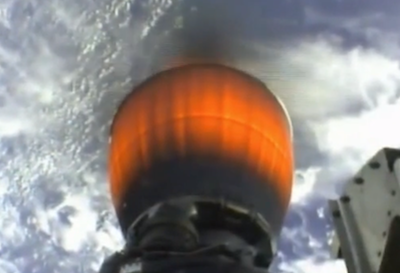Copyright 2017 Robert Clark
Some possibilities for altitude compensating nozzles include actual adjustable-sized nozzles but using non-flexible materials such as ceramics. In such cases the high expansion ratios needed for optimized expansion at high altitude would give nozzles of impractical size, for instance they wouldn't fit within the width of the rocket stage.
A couple of possibilities for dealing with this eventuality:
And:
Vacuum optimized nozzles, whether altitude compensating or not can take a great deal of mass of an engine or stage. See for example the specifications of the Star 48B here:
You see the weight of the nozzle assembly is nearly that of the case assembly. This would become even more of a weight problem with extreme expansion ratios of hundreds to one.
The lightweight space shuttle underside tiles may provide a solution. Their volume density is only 0.144 gm/cm^3. And according to this report their areal density is 1.19 gm/cm^2:
TPS Materials and Costs for Future Reusable Launch Vehicles.
The AETB-8/TUFI listed is a toughened tile material that has higher impact resistance while maintaining the same temperature resistance.
Judging from the size of the size of the Star 48B nozzle, the nozzle weight might be reduced from 90 lbs to ca. 20 lbs using the AETB-8/TUFI tiles.
A possibly even more lightweight material was developed by aerospace engineer/mathematian GW Johnson. He described it in this video presentation at the 16th Mars Society conference in 2013:
Reusable Ceramic Heat Shields - GW Johnson - 16th Mars Society Convention.
Johnson estimated the volume density as only 0.03 gm/cm^3, a third that of the shuttle tiles. Also interesting is that Johnson originally developed the material to act as insulation for ramjet combustion chambers.
Note that even the insulation in the Star 48B solid motor is a sizable weight at 60 lbs, compared to the 129 lbs casing weight. Then Johnson's ceramic might also be able to be used as a lightweight replacement for solid motor insulation.
Bob Clark
UPDATE, 3/6/2018
A problem though is the shuttle tiles and also the Johnson tiles have low tensile strength, only about 1 bar. This probably can be improved by adding strengthening bars to the ceramic as steel rebar is used to improve the strength of concrete.
Additionally, as the exhaust travels down a nozzle towards the exit the pressure also decreases. So perhaps it could be used as the nozzle extension for the nozzle below where the exhaust gas falls below 1 bar pressure. This could result in a significant reduction in weight. See for instance the comparison size of the RL10 nozzle used on the DC-X optimized for low altitude flight compared to one for high altitude, near vacuum flight:
This might be hard to test though for amateurs. Amateurs don't have access to the expensive test equipment used to test engine performance under high altitude, near vacuum conditions.
To do the test at sea level we would need to make the attachment so that the length of the nozzle would make the exit pressure to be quite low. This then entails dangerous loads on the nozzle due to the overexpansion at sea level ambient pressure. This would be made even worse due to the brittle nature of the ceramic.
The most effective test would be on the rockets by university and amateur teams whose rockets have reached 100K feet. The pressure there is only about 1% that of sea level.
The problem with getting a material to work is that it has to be both high temperature and lightweight. But what if it didn't have to be high temperature?
I was puzzled by these images showing the nozzle extensions on rocket engines glowing red hot while firing:
To do the test at sea level we would need to make the attachment so that the length of the nozzle would make the exit pressure to be quite low. This then entails dangerous loads on the nozzle due to the overexpansion at sea level ambient pressure. This would be made even worse due to the brittle nature of the ceramic.
The most effective test would be on the rockets by university and amateur teams whose rockets have reached 100K feet. The pressure there is only about 1% that of sea level.
The problem with getting a material to work is that it has to be both high temperature and lightweight. But what if it didn't have to be high temperature?
I was puzzled by these images showing the nozzle extensions on rocket engines glowing red hot while firing:
RL-10B2 engine with nozzle extension.
Merlin Vacuum engine with nozzle extension.
But when the exhaust extends down a nozzle it both expands and cools. So why were these nozzle extensions glowing red hot?
Perhaps they get red hot because they are heated by conduction by the upper parts of the nozzle where the exhaust gas is still hot.
If so, then we could use the ceramic tiles as insulation between the upper part of the nozzle, and the attached nozzle extension. In that case the nozzle extension would need to be as heat resistant and there would be many more materials that would have the lightweight characteristic required.










